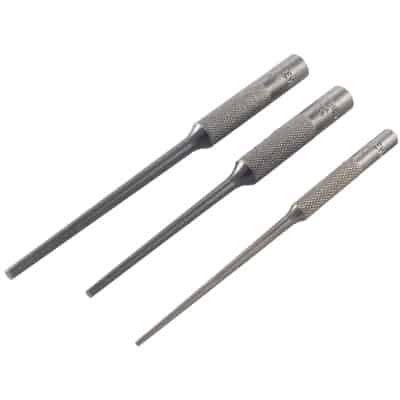
I’m often asked what tools I find most valuable on my bench. With a multitude of hammers, files, and punches, there is always that one tool that you use more than everything else. For me, that is my set of alignment pins. I use them for just about every reassembly on my bench. They make driving a pin in while fighting spring pressure easy, saving countless time.
Alignment pins are tapered pins that help align components for reassembly. They are a great addition to any gun shop or home bench. I use and prefer the Brownell’s Gunsmith Alignment Pins. They are made out of forged steel, meaning they are strong and durable. Each one is taper-ground and polished to fill every need. The knurled handles ensure that you get a good grip during use.
Affiliate Disclosure: This article may contain affiliate links. When you use these links, I earn a small commission from each sale generated at no cost to you. This commission helps me continue to put out free content. I work a full-time job that I am very happy with; therefore, I don’t need this commission and am not obligated to speak highly of any product. Everything written is my own opinion: the good, the bad, and the ugly.

Specs
The alignment pins come in three sizes that cover nearly every situation you’ll find yourself in. These pins are 4″ long overall with the tapered portion being 2 1/2″.
The tapers are as follows; Small 0.070″ – 0.156″, Medium 0.110″ – 0.187″, Large 0.150″ – 0.219″

Using Alignment Pins
Alignment pins are simple to use and make a job like installing an AR-15 Trigger Mechanism much easier. When assembling a firearm, it is very common to have to align a hole in one part with one in another. All while holding it in place, battling spring pressure, and trying to drive a pin in just right.
It is important to resist the urge to use them to drive a pin in or out of a firearm. They are not made for that application and can damage the pinhole if used improperly. The standard punch is not tapered, allowing it to go the whole way through the parts you’re working on. The tapered alignment pins are more for positioning and aligning parts prior to driving a pin in place.
Using Alignment Pins on the Mauser 98

Installing a Mauser military trigger mechanism is another great application for alignment pins. Fighting the stiff sear spring can be very difficult while trying to drive in the sear pivot pin. With the barreled action secured in a padded vise, hold the alignment pin in your left hand. Insert it into the sear pivot pin hole and receiver, start the sear pivot pin on the opposite side. Lightly tap the pin in place, your alignment pin should start to drive out towards you as the pin pushes it out of the way. Once you feel it start to go in properly you can remove the alignment pin and finish driving it in.
Use coupon code KTG10 to get 10% off your order of $150 or more at Brownells.
Make Your Own!
It is very possible to make your own alignment pins, however, you have to analyze the time it will take you and the cost of buying one. Brownell’s set of three currently costs $22.99. If you are a home hobbyist with a lathe then time may not be an issue, but if you run your own shop you definitely need to consider how long it will take you to make them. If you need $50 per hour to keep your lights on, you need to be able to make all three of these in about 25 minutes to get your money’s worth. I really enjoy making my own tools and jigs, but this is a prime example of where it may be beneficial to just purchase them and move on.
How to Make Your Own Bench Block!

Written by: Kurt Martonik
Kurt is a Gunsmith, Reloader, Hunter, and Outdoorsman. He grew up in Elk County, Pennsylvania, where he became obsessed with the world of firearms. Following high school, Kurt enlisted in the United States Air Force as a Boom Operator, where he eventually rose to the position of Instructor. After his military service, he attended the Colorado School of Trades(CST) in Lakewood, CO for gunsmithing. Following graduation, he accepted a job at C. Sharps Arms in Montana, where he worked as a full time stockmaker and gunsmith.